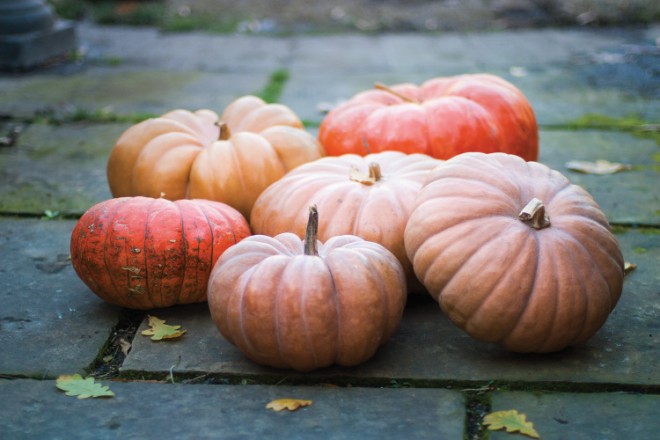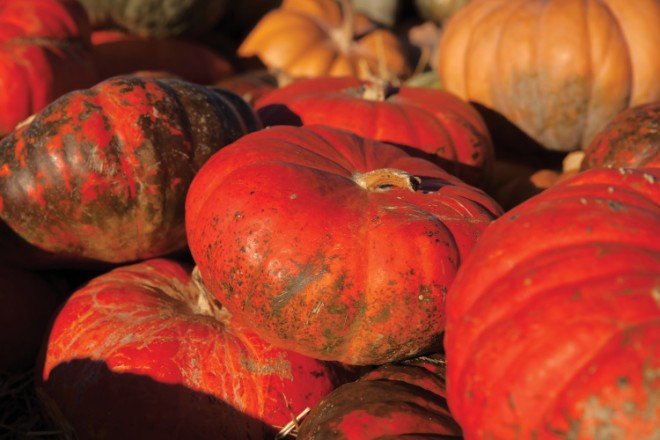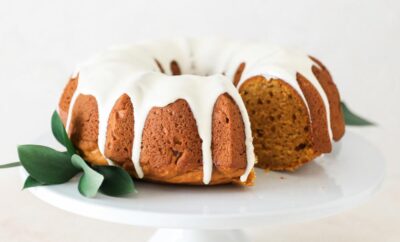Gourd-ness Gracious: It’s Pumpkin Season

It may still be summer outside, but fall days are just around the corner. If you’re anything like me, I love to start decorating and using pumpkins at the first hint of autumn.
If you’ve ever wondered about growing your own pumpkins, you have to plan and plant by mid-June so your pumpkins have plenty of time to mature. It’s a bit too late this year if you haven’t already started your seeds, but keep these tips in mind for next year to ensure a bountiful harvest. You can also use this information when selecting varieties of pumpkins at your local farmers market, nursery or roadside stand, or when harvesting from a local patch.
A Plethora of Pumpkins
Whether you’ve grown your own pumpkins for years or you have picked them up at local nurseries, it probably comes as no surprise that there are numerous varieties available. Here are a few of my favorites:
Long Island Cheese pumpkins have the look of a traditional pumpkin with a slightly more brownish orange skin and are excellent for making pies. The Rouge Vif D’Etampes has a red-orange skin and grows to be anywhere from 10 to 15 pounds. The New England Pie makes an excellent jack-o’-lantern candidate. Finally, Lumina pumpkins have a classic round shape, but they’re white instead of traditional orange, which make them great for decorating.
If you’re looking for something with a bit of character, try the Toad pumpkin. It’s a smaller variety that has an abundance of warts on its bright orange skin.
Starting From Seed
Whatever you choose, know that you’ll need plenty of space to grow pumpkins. Whether you’re planting a large or small variety, their vines require an expanse of space to stretch out and grow.
Growing pumpkins from seed starts out much like any other plant. Plant the seed in a small container or pot, and allow it to mature to a seedling in the comfort and protection of your greenhouse, sun porch or even on your kitchen counter in front of a bright, sunny window. This process should take two or three weeks.
See More
When you have a seedling that is rooted in, it’s time to transplant. Pumpkins like warm soil, so wait at least two weeks after the last spring frost to plant them in the ground.
As for the composition of your soil, you’ll want to amend the planting area with a generous amount of compost or well-rotted manure. Unless your soil is nitrogen poor, don’t add nitrogen. Too much of this nutrient will result in lots of leaves but will produce few flowers.
Space the plants approximately 1 foot apart in hills that are roughly 3 feet in diameter and 6 inches high. Or you can set out one plant per hill if you prefer. Keep in mind the pumpkins will vine and spread out.
Water your pumpkins early in the day and low to the ground using a soaker hose or drip irrigation system. This will help keep the foliage dry and prevent fungal diseases like powdery mildew.

Harvest Time
Depending on the variety you chose, your pumpkins will mature in just three to four months. You’ll know the pumpkin has reached its harvest time when the rind is hard and its color is fully formed. I like to test my pumpkins by running the end of my fingernail against their outer skin. If it resists puncture, then I say it’s ready to harvest. You’ve probably heard that you can also tell if a pumpkin is ripe if you hear a hollow sound when it’s thumped. That’s another foolproof test that I recommend trying if you aren’t sure.
You need to gather the pumpkin harvest before the first frost or when night temperatures are expected to drop down into the 40s for an extended period of time. When you bring them in, gently clean the pumpkins by brushing off any excess dirt, and then place them in a dry, warm area for 7 to 10 days. This will heal any scratches they may have and help the rind continue to harden, which helps reduce moisture loss. If a frost is expected and they will still be exposed to elements, cover them with a frost blanket overnight.
After they have been cured, keep your pumpkins in a cool location (about 50 to 60 degrees), out of direct sunlight with plenty of good air circulation. If you store your pumpkins this way, you should be able to enjoy their beauty for up to three months – perfect timing for the autumn season!
















I’ve seen some pretty wild looking winter squash; can you recommend an heirloom variety that can go as a meal and in a pie?